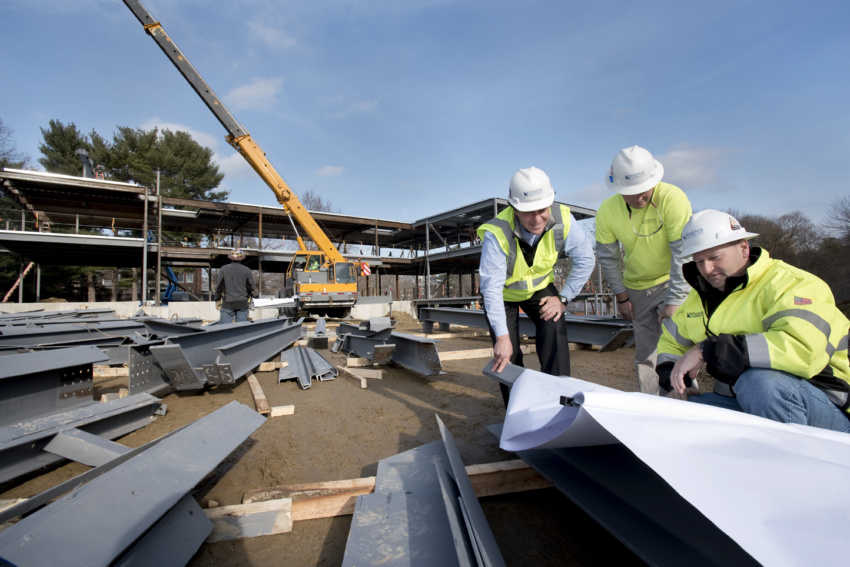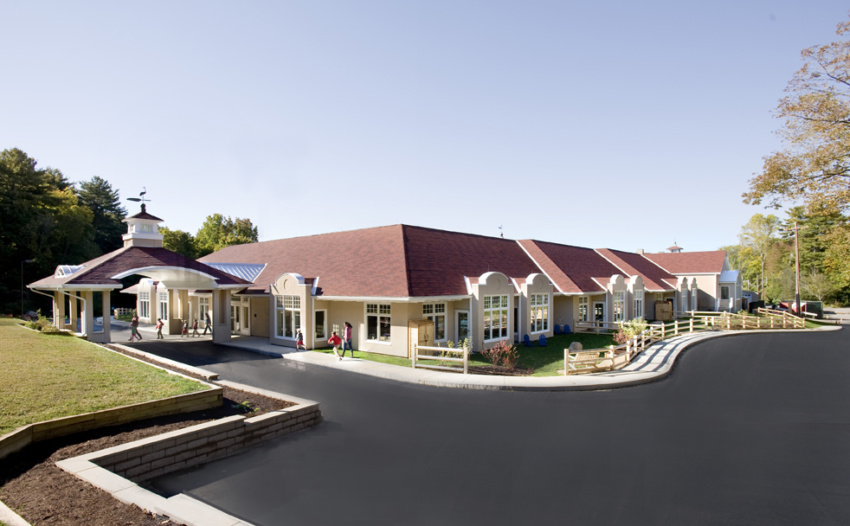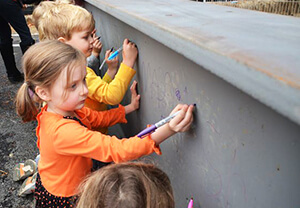Construction on academic campuses, especially when school is in session, requires careful planning and design, and most importantly close attention to safety. Instilling a strong safety culture in the fabric of our organization is where we start, and this mindset extends to our jobsites.
Working on a wide range of K-12 and higher education projects throughout New England, we’ve developed a range of best practices that maximize safety and minimize disruption. Here are our top three:
1. Adapt construction schedules
 It’s important to understand what goes on beyond the construction fence. Many builders know how to manage what happens within the limits of a site, but it’s the attention to all details around the project that ensures safety and minimizes disruption on active campuses. This starts with understanding adjacencies to the construction site: whether they be interior spaces such as classrooms, hallways, libraries, etc. or abutting structures or buildings, and getting to know the schedules for using those spaces – typical circulation patterns in and around them, and examining daily vehicular traffic flow (if a roadway runs nearby).
It’s important to understand what goes on beyond the construction fence. Many builders know how to manage what happens within the limits of a site, but it’s the attention to all details around the project that ensures safety and minimizes disruption on active campuses. This starts with understanding adjacencies to the construction site: whether they be interior spaces such as classrooms, hallways, libraries, etc. or abutting structures or buildings, and getting to know the schedules for using those spaces – typical circulation patterns in and around them, and examining daily vehicular traffic flow (if a roadway runs nearby).
Studying traffic patterns is one of the key parts of the planning process. We arrange trucking/delivery traffic plans early on to accommodate the needs of each campus. This ensures that construction traffic does not interfere with the school’s daily pickup and drop off, and builds in another preventative safety measure for all students, faculty, staff and visitors walking on campus.
In 2015, Windover completed a lower school and dining addition at Brookwood School in Manchester-by-the-Sea, Mass., where construction wrapped around occupied classrooms. A just-in-time schedule allowed learning and activities, such as student pick-up or drop-off, to continue uninterrupted despite the proximity to construction.
Working around the school schedule is non-negotiable and there will be instances where construction activities will need to be curtailed or halted. As a part of developing the Master Construction Schedule, we maintain open communication with school administrators so they can express their needs and identify sensitive campus events such as exam periods, move-in dates, or graduation. Having this information allows the builder to orchestrate the schedule so disruptive work is planned around these events, during vacation, or off-hour periods.
2. Active, Constant Communication
With solid channels of communication in place that create a continuous stream of information between the builder and the school, classes and construction can coexist.
 Communication is essential in keeping everyone, from students and faculty to staff and parents, informed from the project onset. It eases any initial concerns and increases their willingness to deal with the changes or inconveniences that construction may present. These early conversations during preconstruction should cover the following topic areas:
Communication is essential in keeping everyone, from students and faculty to staff and parents, informed from the project onset. It eases any initial concerns and increases their willingness to deal with the changes or inconveniences that construction may present. These early conversations during preconstruction should cover the following topic areas:
- drop-off/pick-up times and locations
- trucking patterns and deliveries
- academic schedule (exam periods, lunches, special events, recesses, etc.)
- emergency communication approach
- process for daily communication and check-ins
Collaboration within the project team is important to facilitate an open dialogue where the academic institution’s needs and concerns are heard. Consistent daily check-ins, weekly meetings and site walks hosted by the project team are a great way to streamline essential information.
On many academic projects, we host informational forums for parents and faculty to engage them in the planning and give them the opportunity to share concerns they may have. Inviting them to participate in this way fosters a strong trusting partnership and creates excitement around the process.
3. Incorporating Construction into the Curriculum
The ability to integrate construction with learning derives from the partnership the builder and the school share. We’ve seen this evolve in many ways from students touring the construction site, to having our construction professionals teach in the classroom to having students involved in the design of the project. Each school embraces the process in individual ways due to the age of students, but it’s always great to see the kids using the opportunity to learn new and exciting things about construction first-hand.
 Two projects where this approach was successful was for Brookwood School in Manchester-by-the-Sea, Mass. and St. John’s Prep in Danvers, Mass. At the Brookwood School we completed a logistically complex addition that abutted classrooms. The Brookwood community embraced the process and designed curricula around the construction to engage its students. Instead of cordoning off the space, students assisted in the project’s groundbreaking, participated in weekly tours of the construction site, created update reports, shot weekly videos of the progress and attended the topping-off ceremony, and even signed the final beam before installation. At St. John’s Prep, members of Windover’s team had the opportunity to teach high school students some fundamentals in construction, such as the importance of recycling materials, physics, planning and design.
Two projects where this approach was successful was for Brookwood School in Manchester-by-the-Sea, Mass. and St. John’s Prep in Danvers, Mass. At the Brookwood School we completed a logistically complex addition that abutted classrooms. The Brookwood community embraced the process and designed curricula around the construction to engage its students. Instead of cordoning off the space, students assisted in the project’s groundbreaking, participated in weekly tours of the construction site, created update reports, shot weekly videos of the progress and attended the topping-off ceremony, and even signed the final beam before installation. At St. John’s Prep, members of Windover’s team had the opportunity to teach high school students some fundamentals in construction, such as the importance of recycling materials, physics, planning and design.
In both instances, the schools embraced the construction process and rallied behind it rather than try to hide it. The relationship and trust we shared with each of the schools paved the way for this creative integration and enabled our team to be true members of their academic communities.
